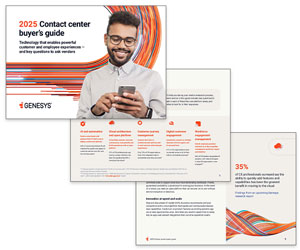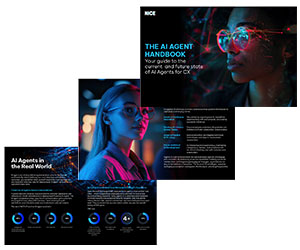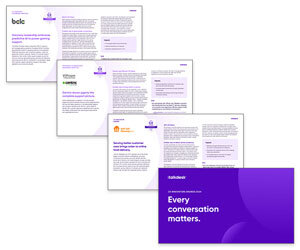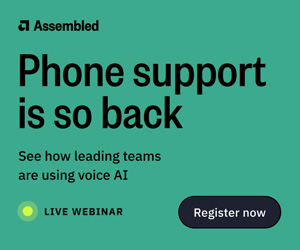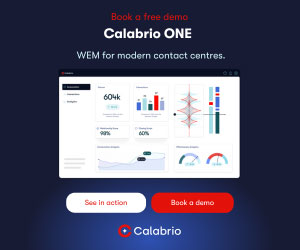Experiencing uncertainty – that nagging feeling of not knowing what happens next – can leave customers stressed and anxious.
This not only impacts their experience, but also has serious consequences for contact centres, leading to increased call volumes and even customer churn.
So, how can contact centres reduce customer uncertainty for all-round better CX? We asked our consultants panel to find out.
Here’s what they said….
How to Reduce Customer Uncertainty
1. Put a “Captain Chaos” Role on Rotation Each Week

When chaos strikes (because it will), someone needs to own it. I had a “Captain Chaos” role on rotation each week.
They’re the one responsible for putting out fires and keeping customers from going nuclear. They’re the customer’s (and agent’s) last line of defence against utter confusion.
But here’s the real game-changer: empathy. Train your team to not just understand customer frustration, but to genuinely feel it. To step into their shoes and experience the world through their eyes. That’s where the magic happens.
Contributed by: Michel Stevens, Customer Experience Master (CXM)
2. Give Customers a Direct Number to Reach an Agent If They Need To

Agents should anticipate common questions and provide step-by-step guidance.
For example, rather than waiting for a customer to ask, “What happens next?” an agent could say something such as “Here’s what you can expect over the next few days. Feel free to reach out with any questions in the meantime. My direct number is … and I am available from … to …”.
This eliminates guesswork and reassures customers that they are in capable hands. It also reassures customers that they can reach out if they feel they need to, which generates a sense of trust and reliability.
Contributed by: Pierre Bauzee, Founder of Beyond Satisfaction
3. Train Agents to Stop Mirroring Customers’ Anxiety (and Respond Calmly Instead)

Addressing uncertainty can be as simple as agents adjusting their tone of voice.
If a customer phones up and says, “Where’s my parcel? It’s my niece’s birthday!” and your agent responds with, “Oh my gosh, I’m not sure, we’re so busy at the moment! I don’t know what to tell you. There’s been a lot of fog to deal with and I have no idea where your parcel is”, the situation is only going to get worse, as agents mirror the customer’s anxiety and provide no clear answer!
Instead, your agents need to handle these queries with a calming tone, controlled tempo, and carefully chosen words to show empathy and confidence – all to increase the customer’s sense of certainty that everything is under control.
Contributed by: Stephen Pace, “The Contact Centre Motivator” at Optymyse Ltd.
If you want advice on how important it is for agents to be aware of their tone of voice, read our article: How to Utilize Tone of Voice in the Contact Centre
4. Use Predictive Analytics to Identify Potential Pain Points

By analysing customer data, contact centres can identify potential pain points and causes of uncertainty – then proactively address them.
For example, predictive analytics can identify customers at risk of churn and trigger targeted interventions to improve retention.
Contributed by: Dan Pratt, Founder & Director of DAP Consultancy
For advice on the main contact centre pain points and suggestions on how to solve them, read our article: What Are the Main Call Centre Pain Points, and How Can They Be Solved?
5. Set Expectations and Get to the Point Fast!

One of the first things I learnt in stand-up comedy is to get to the point and get to the point fast!
Many times, when I first started in that business, I would start telling a joke. It’s a long-winded set-up, I’m halfway through, and the audience is staring at me wondering where I’m going with it.
This is exactly how customers feel when they’re navigating a process that’s unclear. They’re in the audience, hoping for a smooth experience, but instead, they’re stuck in suspense – unsure if there’s a punchline or just a slow fade to silence.
So, how do you fix it? You use the same techniques that make a comedy set work. In comedy, the first joke sets the tone. It needs to be upfront and fast.
If you come out swinging with one of your best jokes, the audience knows they’re in good hands. The same goes for customers. You need to let them know upfront what they can expect.
And most importantly, so that you ensure your customers return satisfied, you need to deliver.
For example:
- In comedy: “Good evening, folks! I’ve got 10 minutes, and I promise 8 of them will be funny.”
- In customer service: “Here’s what’s happening next: You’ll get a confirmation email in 5 minutes, and delivery is scheduled for Friday. If anything changes, we’ll let you know right away.”
Contributed by: Dara Kiernan, leadership development and contact centre consultant
6. Guide Customers With Micro-Tasks

With the US tax season under way, TurboTax stands out as a brand that excels at reducing customer uncertainty.
Here’s how. TurboTax turns a notoriously complex, confusing, and stressful experience into something manageable by breaking it down into clear, simple steps.
Instead of overwhelming customers with the entire filing process at once, it guides them with micro-tasks: “Let’s start with your income,” “Now, let’s tackle deductions.” Then a visual progress bar helps reassure them that they’re on the right track.
Contributed by: Matt Lyles, Keynote Speaker, Brand Consultant and Podcast Host
7. Stop Your Agents Saying “Don’t Worry”

DO. NOT. SAY. DON’T WORRY.
Agents should listen to the customer’s question and work out how to answer it.
Your contact centre is not infallible.
There is a good chance that communications are insufficient. Or even that the risk seen by the customer will come to pass.
Contributed by: Michelle Spaul, Customer Experience Management Consultant
8. Train Agents to Ask Diagnostic Questions to Fully Understand the Issue

Customer may feel anxious due to a lack of trust in the contact centre.
To address this, train your agents to build trust throughout their interaction by:
- Showing empathy – Acknowledge the customer’s feelings and concerns.
- Asking diagnostic questions – Seek to fully understand the issue.
- Explaining clearly – Provide straightforward information about to answer the customer’s questions and solve problems for them.
- Checking for understanding – Confirm if the customer accepts the proposed solution and if they have any questions.
- Closing the interaction well
- Summarize key points – Confirm what was discussed and agreed upon.
- Outline next steps with deadlines – Let the customer know exactly what to expect and when.
- Use follow-up reminders – Leverage your contact centre CRM to remind agents of timely follow-ups. (To go above and beyond, agents should under-promise and over-deliver. For example, if an agent promises to call back by noon, they should plan to call at 11:00 or 11:30. This creates a buffer for unforeseen delays and builds trust by exceeding expectations.)
The best way to calm customer anxiety is to consistently deliver. Fix the issue on time and communicate effectively – that reduces anxiety and builds trust.
Contributed by: Mike Aoki, President of Reflective Keynotes Inc.
If you want advice on the best questioning techniques for customer service, read our article: 6 Effective Questioning Techniques for Customer Service
9. Avoid Multiple Communication Streams That Muddy the Waters

Beware increasingly complex CX solutions that partly aim to replace the mundane communications of agents but often end up creating multiple communication streams for consumers that further muddy the waters.
For example, I’ve personally been in a situation where I bought something and so was receiving communications on the delivery and set up of this item, whilst also being marketed to, by the same company, for the same item! Madness!
Contributed by: James Parkin, Founder of Ellison Coast
10. Make Sure Any Promised Callbacks Happen Exactly as Stated

Consistency in delivery is important. A promised callback, resolution, or update must happen exactly as stated.
When customers are left waiting or are forced to chase updates themselves, anxiety increases, and their trust erodes.
Regular proactive updates, even when there is no significant progress, reassure customers that they have not been forgotten and that their issue remains a priority.
Contributed by: James Edmonds, Managing Director at Duty CX
11. Empower Customers With Self-Service Tools

Cognitive Appraisal Theory explains how we evaluate events through two lenses: primary appraisal (is this relevant to me and potentially harmful?) and secondary appraisal (do I have the resources to handle it?).
In the context of customer uncertainty, anxiety often arises when customers perceive their expectations are going unmet, and some level of detriment may result (this can be as simple as having to wait longer than expected).
Organizations must understand how customers make these appraisals to reduce customer uncertainty.
This can be achieved in many ways, including:
- Self-Service Empowerment – Equip customers with tools and resources (FAQs, real-time tracking, chatbots) that allow them to resolve issues independently, reinforcing their secondary appraisal and reducing anxiety.
- Iterative Feedback Loops – Continuously gather customer feedback to identify clarity or process efficiency gaps. Use insights to refine systems and reduce future uncertainty.
Contributed by: Katie Stabler, CULTIVATE Customer Experience by Design and author of CX-Ism: Re-Defining Business Success COMING SOON!
12. Walk in Your Customers’ Shoes and Record Every Possible Requirement

You cannot reduce customer uncertainty until you first have certainty yourself. That may sound like something from a fortune cookie, but the chances are if your customer is stressed or anxious, then there’s a basic need you’ve not captured or delivered on.
Do you have a clear and current understanding of customer needs from every stage of your journey?
Walk the steps and record every possible requirement and outcome – it may sound arduous, but it’s what your customers expect from you.
Look at your journey stages and the communications surrounding those moments to consider this five-point checklist:
- How are you meeting those needs?
- Are you clear on what you will (and won’t) do?
- What does the customer need to do (if anything)?
- What are the timeframes?
- And when will they hear from you again?
If a customer does get in touch, how does your CRM arm your advisors to make that query as easy to deal with as possible?
It should list their journey stage, the last received communication, and behavioural data to give clues as to what the conversation will be about.
Ensure there’s a space for your agents to then easily pull together those queries, share them internally and route that back to the communications team to build the feedback into new drafts – reducing future contacts relating to the same issue.
Contributed by: Mark Allaway, Evosa
13. Create a Wall of Shame of the Top 10 Customer Issues
We all love the “happy path”. We’ve made our plans, processes and flows based on a happy path in each of the customer phases, but the truth is that customers are rarely on that path.
To address this, one trick I’ve used for many years is the Wall of Shame. It’s a wall in our office with the top 10 customer issues, ranked by severity and by how much they really hurt.
It’s an eyesore, and a constant reminder to dig into the data and figure out how long each actually takes to fix and then go for it. No more silos, no more finger-pointing!
Contributed by: Michel Stevens, Customer Experience Master (CXM)
14. Tailor the Experience (Know Your Audience)
A good comedian reads the room. A joke that kills in Ireland might flop in London if you don’t know your crowd. Similarly, customers aren’t all the same – they need personalized experiences.
Example:
- In comedy: “Anyone here from Ireland? Ah, great! You’ll understand why this next joke involves Guinness and Bog-Snorkelling.”
- In customer service: Use customer data to tailor interactions. “Hi Dara, I see you’ve called about your recent delivery. Let me check that for you now.”
Contributed by: Dara Kiernan, leadership development and contact centre consultant
If you want advice on how to deliver not only a great customer experience, but a personalized one, read our article: 21 Steps to a More Personalized Customer Experience
15. Recognize and Reward Agents Who Deliver Exceptional Customer Service
And last but not least, recognize and reward agents who consistently deliver exceptional customer service!
This can create a positive and customer-centric culture, which actively avoids customer uncertainty.
Contributed by: Dan Pratt, Founder & Director of DAP Consultancy
Reducing Uncertainty Is the Foundation of Loyalty
Ultimately, reducing uncertainty is about making the customer feel valued and in control. When you deliver on what you promise, you earn their trust, and that trust is the foundation of loyalty.
What Do You Do to Reduce Customer Uncertainty in Your Contact Centre?
Join our LinkedIn community and let us know.
To discover more great ways to improve your customer experience and connect with your customers, read these articles next:
- 3 Steps to Better Understanding Your Customers
- Capture Customer Needs – Just Like This!
- The 5 Pillars of Customer Experience (CX)
Author: Megan Jones
Reviewed by: Xander Freeman
Published On: 19th Feb 2025
Read more about - Customer Service Strategy, Customer Service, CX, Dan Pratt, Dara Kiernan, James Edmonds, James Parkin, Katie Stabler, Mark Allaway, Matt Lyles, Michel Stevens, Michelle Spaul, Mike Aoki, Pierre Bauzee, Stephen Pace, Top Story












